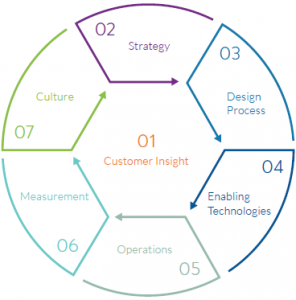Today’s post marks the beginning of the final section of this blog series dedicated to adapting customer experience (CX) strategy to life sciences. The previous four posts set the stage for what we’re about to do, but if you’re just finding this series now, don’t worry – this final section will still be worth your time.
The source for the content of this blog series is the guide recently published by my colleagues in Perficient Digital, Building Your CX Strategy: Seven Dimensions for Success. In that guide, they explain the shifts in the marketplace – largely on the retail front – and my previous posts have attempted to explain why what’s happening in retail matters in life sciences.
Now it’s time to dive in to the heart of the guide, starting with an overview of the seven dimensions of an effective CX strategy.
CX as a strategy depends on ongoing, top-down, company-wide commitment to creating, delivering, and sustaining the experiences that matter to your customers. If you recall from previous posts, “customers” in life sciences means a lot of different groups, including patients, physicians, clinical sites, vendors, partners, regulatory agencies, investors, even your employees.
Creating consistently great experiences for your customers revolves around a deep (data-based) understanding of each of your customer groups. Once you have those customer insights, you need to align them with your overall business strategy, and then execute that strategy through a thoughtful design process.
Technology is now essential to delivering the experiences that customers have come to expect, and that same technology also plays a crucial role in sensing, measuring, and reacting to customers’ actual experiences.
Additionally, the ongoing operational and cultural commitment to measure your CX performance and adapt and change with your customers is essential to sustaining their loyalty.
This leads us to the seven dimensions of an effective CX strategy:
In the remaining posts in this series, we’ll take a look at each of these dimensions in detail. In the meantime, feel free to download the guide I mentioned above.


